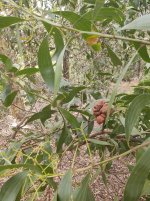Time of year does seem to matter.. end of summer for many species is revered as a high tryptamine time. Same with winter. This is probably in correlation with flowering time. That said.. for testing, now is always a good time as your understanding of the species will become more nuanced.
For a quick test, oven drying material and then grinding to a fibre/powder will do fine

this is something i have been wondering about, is it the case that DMT is higher during flowering? or just before/after?
I havent seen someone explicitly mention this, for vegetables at least flowering is not a great time for harvest, but this is a tree of course haha.
Fortunately at least, DMT is always there, just not as much or consistently all year round if you can ID the thing without the flowers.
Thanks to cyclone alfred theres a lot of acacias around here now which have snapped branches, so soon ill be collecting some samples to run colormetric testing on, and i get to benefit from this short term access to sustainable wood-bark.
Another question i have: for something like maidenii, or leiocalyx, or any others that are very similar in appearance and found in the same places, lets call them maidenii-like, low DMT content, and lots of fat, wax and resin, like acuminata on the opposite of steroids, what would be a good strategy for field-testing for whether a given tree is worth collecting from? ideally you dont want to spend time and resources processing empty leaf/bark but, you are taking from the tree too, if you can avoid a weaker / non active or lookalike that would be great. Has anyone developed a shortcut method to apply say, marquis reagent out in the field? i assume some degree of extraction is required before any DMT is concentrated and clean enough for the test to produce useful results.
Best i could think of was burning a small piece of bark or leaf in a test tube under hard vacuum since hand pumps can get small volumes easily down to about -700mmHg in my experience, and then testing that assuming a smell test at that point wasnt sufficient.
I accidentally distilled the DMT out of the collective toluene pulls from ACRB because the oil was so clear i didnt notice it getting thick and thought i could distill off more solvent before doing FASA. turned out i had a LOT of fats and other gunk there, or they held onto toluene really well, either way, it started smoking and later i collected 30mg of dmt from the toluene distillate. since i used a shortpath, i think i lost a lot as smoke in the time i had my back turned, the worst kind of condenser for entraining smoke.





